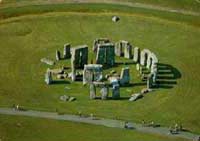|
Stonehenge in
Wiltshire
|
 The most famous prehistoric monument in Britain is the geometrically arranged circle of stones known as Stonehenge. Work first began at Stonehenge somewhere around 2000 BC when a circle of holes was dug. Construction resumed between 1700 and 1600 BC when 80 blue stones from the Prescelly Mountains in Pembrokeshire were placed to form two circles. Eighty large sarsen stones were then placed outside these circles to form an outer circle. In the center of this is a sandstone block that is now called the Altar Stone. Around 1300 BC another circle of blue stone rocks was created.
The most famous prehistoric monument in Britain is the geometrically arranged circle of stones known as Stonehenge. Work first began at Stonehenge somewhere around 2000 BC when a circle of holes was dug. Construction resumed between 1700 and 1600 BC when 80 blue stones from the Prescelly Mountains in Pembrokeshire were placed to form two circles. Eighty large sarsen stones were then placed outside these circles to form an outer circle. In the center of this is a sandstone block that is now called the Altar Stone. Around 1300 BC another circle of blue stone rocks was created.
The reasons behind the formation of Stonehenge are not understood, but it is known that the axis is aligned with the sunrise on the twenty-first of June, the longest day of the year. Upon paying the admission fee, audio headphones are given that explain the extraordinary stones of Stonehenge. A gate surrounds the stones to prevent visitors from getting closer than fifty feet from the stones and to protect the site from vandalism.
|
|